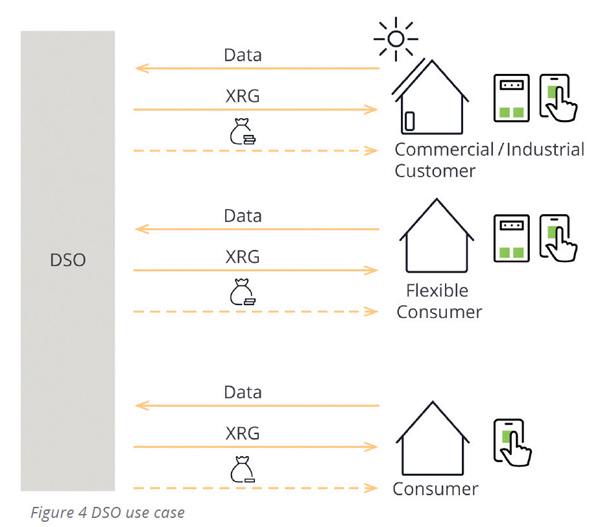Physicists define exergy as the portion of energy available for useful work in our economies – the part that doesn’t get lost in thermodynamics or general inefficiency. Exergy is also a project team of LO3 Energy, a company that operates what has come to be known as a transactive energy system in New York City, using blockchain technology to mediate household-scale energy exchanges between suppliers of electricity from rooftop solar installations and household purchasers. (See the June 2017 issue of IPPSO FACTO for a feature story on the Brooklyn Microgrid.)
 Example of an energy transaction between an energy-generating household and a consuming household, mediated by XRG tokens.
A technical whitepaper by the group argued that we should not consider kWh as the sole attribute of energy service, when it’s equally crucial where, how and when those kWh were generated for use. As grid edge energy solutions are adopted, the paper describes how a transactive energy marketplace optimizes for lowest cost, lowest carbon, and more resilient networks supported by consumers, new energy service providers and system operators alike.
Example of an energy transaction between an energy-generating household and a consuming household, mediated by XRG tokens.
A technical whitepaper by the group argued that we should not consider kWh as the sole attribute of energy service, when it’s equally crucial where, how and when those kWh were generated for use. As grid edge energy solutions are adopted, the paper describes how a transactive energy marketplace optimizes for lowest cost, lowest carbon, and more resilient networks supported by consumers, new energy service providers and system operators alike.
 Distribution grid operators can also use the XRG data for system balancing.
In the US, the group says, some estimates show an 86 percent inefficiency in converting energy sources and conveying it to locations where it can be turned into useful work. In the process, the waste creates pollution, health problems and climate change. “This problem has emerged because in the current power sector business models, utilities use outdated constructs of its consumers as rate payers, missing the opportunity and value only a customer can provide,” the group says.
Distribution grid operators can also use the XRG data for system balancing.
In the US, the group says, some estimates show an 86 percent inefficiency in converting energy sources and conveying it to locations where it can be turned into useful work. In the process, the waste creates pollution, health problems and climate change. “This problem has emerged because in the current power sector business models, utilities use outdated constructs of its consumers as rate payers, missing the opportunity and value only a customer can provide,” the group says.
Today, traditional utility businesses can no longer simply rely on demand for the kWh commodity, the group argues. Nor do they need to, thanks to developments like smart energy services, battery storage, and rooftop solar PV, all “popping up at the grid edge.” The company sees “citizens, communities and energy consumers everywhere ... resetting the rules of the marketplace.” They find that 69% of consumers would like to be able to buy local or differentiated energy products, but a transactive energy platform is needed for such a model to function. LO3 has developed its own XRG token for use in its blockchain system. “Network participants need only the use of a smartphone app and staked XRG account to be engaged in the Exergy marketplace. ... Accordingly, many network nodes will look quite simple—requiring only light computation yet transacting securely and efficiently.”
Exergy says its current pipeline includes 45 global projects with partners at varying stages of development. Projects range in size from a minimum of 5 participants to hundreds.
